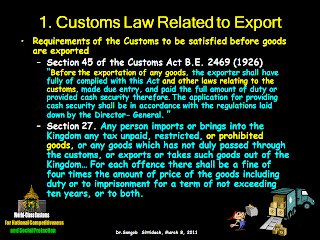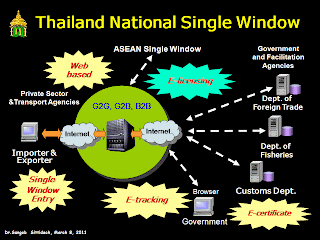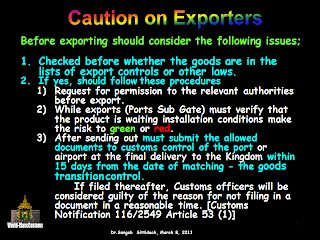ผ่อนสบาย ๆ เดือนละหมื่นกว่าบาท 24 เดือน ได้เป็นเจ้าของทันที สนใจติดต่อด่วน
Customs Law Concerning the Strategic Trade Control
By WMD CIT working group
February 20, 2012
At the Customs Department
Dr.Sangob Sittidech
Customs Technical Officer, Professional
WMD CIT working group
Customs Law Concerning the Strategic Trade Control by WMD CIT working group
1. The Strategic Trade Control
Customs is now playing the major role to balancing facilitation and control the movement of goods
Vision Statement
World-class Customs for competitiveness and social protection
Mission
1. To provide modern, expeditious, and global standard Customs service
2. To promote economic development and national competitiveness by implementing Customs-related measures
3. To enhance efficiency in Customs control, targeting at social protection
4. To collect revenue in an efficient, fair and transparent manner
Strategies
1. To develop Customs measures, targeting at national competitiveness
2. To develop capacity for Customs control, focusing on the international standards
3. To manage a revenue collection system, focusing on the good governance principle
2. on WMD CIT Working Group
1. WMD CIT working group is in short of … Weapon of Mass Destruction Commodity Identification Training
2. Established by the Department of Customs on April 18, 2011 with the cooperation of the Export Control and Related Border Security, the U.S. Embassy in Thailand
3. The purpose of WMD CIT working group
3.1 To train customs officers to involve in the control of import - export and to gain knowledge of materials and equipment related to WMD as specified in the control lists: NSG, AG, MTCR, WA
3.2 To acknowledge the international rules of conduct related to WMD - that is two-ways
3.3 To acknowledge the various laws, related to the WMD
3.4 To recognize the threat of terrorism with weapons of mass destruction
3.5 To inform the preparation of accounting and control system for Thai exports
3.6 To prepare the export control system that works two ways
3.3 To acknowledge the various laws, related to the WMD
3.4 To recognize the threat of terrorism with weapons of mass destruction
3.5 To inform the preparation of accounting and control system for Thai exports
3.6 To prepare the export control system that works two ways
3. This systematic approach to control WMD
3.1 Input 4 Ms LT
All elements in the preparation of WMD (chemical weapons, biological, nuclear and missile)
1. Man / Human: Personnel intermediary brokerage network in the illegal procurement
2. Money / Capital: Sources of investment funds
3. Material: Raw materials, components, machinery and equipment manufacturing
4. Technological: Software technology and green films
5. Logistics & Supply Chain: Transportation System import, export, transfer / Tran-shipment, transit (The 3-5 is a Dual-use Goods)
6. Managerial: Management
3.3 Output
1. Chemical Weapons (Chemical)
2. Biological Weapons (Biological)
3. Nuclear Weapons (Nuclear)
4. Missile (Missile)
– Ballistic missiles with ranges exceeding 300 km and more than 500 kg payload
3.4 Feed Back – Integrated Control
1. International regulations related to WMD - in the framework of multilateral / UN
1.1 In a multilateral framework:
NSG, AG, MTCR, WA, EC
1.2 The United Nations:
NPT, CTBT, CWC, BWC, UNSCR 1540,
UNSCR 1718
2. Domestic law relating to the control of import / export WMD: 11 volumes
3. Trade measures and the monitoring of IAEA
4. Domestic law relating to the control of import / export WMD
Law and Regulations - Security Council resolution 1540 (2004): WMD
• The Customs Act (1926)
• The Act Controlling the Exportation of Arms, Armament and War
Implements (1952)
• The Atomic Energy for Peace Act (1961)
• The Export and Import Goods Act (1979)
(Cabinet resolution of July 20, 2010 - delegated to the Ministry of Commerce is the main agency in the preparation of management import - export of goods that are available dual‐use product.)
• The Disease Control Act (1980)
• The Munitions of War Control Act (1987)
• The Royal Decree Controlling the Exportation of Arms, Armament
and War Implements (1992)
• The Hazardous Substance Act (1992)
• The Amendment to the Anti-Money Laundering Act (1999)
• The Animal Disease Control Act (2001)
• The Pathogens and Toxins Act (2001)
• The Amendment to the Section of 135 of the Penal Code
5. Integrating with Customs laws and regulations related to the import / export of WMD
Copyright by
Dr.Sangob Sittidech
February 21, 2012


























.gif)


